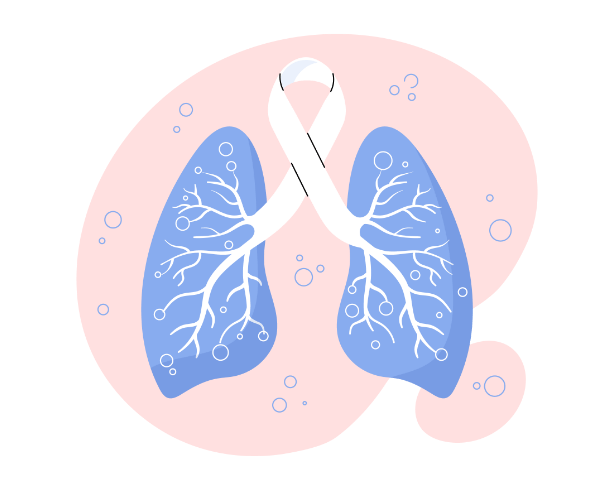Lung Cancer
Lung cancer is a complex disease characterised by the abnormal growth of cells within the lungs, often forming malignant tumours.
It stands as one of the foremost cancers diagnosed worldwide and represents around 9.1% of all new cancer diagnoses in Australia, making it the fourth most diagnosed cancer in Australia for both men and women. The condition manifests in various forms, each presenting unique challenges in diagnosis and treatment. Here we will explore these types of lung cancer, their causes, symptoms, how they are diagnosed, and how they are treated.

Types of Lung Cancer
Lung cancer is divided into two main types: non-small cell lung cancer (NSCLC) and small cell lung cancer (SCLC). NSCLC is the most common, with different subtypes like adenocarcinoma, squamous cell carcinoma, and large cell carcinoma. On the other hand, SCLC is less common but spreads quickly and is more aggressive.
Symptoms of Lung Cancer: Understanding the Signs
Recognising the symptoms of lung cancer is crucial for early detection and timely intervention. Here's a detailed exploration of both early and advanced-stage symptoms:
Causes of Lung Cancer: What You Need to Know
Understanding the various factors that contribute to the development of lung cancer is crucial for prevention and early detection. Here's a closer look at the main causes:

Diagnosing Lung Cancer
When it comes to diagnosing lung cancer, a series of comprehensive tests and procedures are employed to confirm the presence of malignancy, determine its extent, and inform treatment decisions. From initial screenings to advanced molecular testing, each step in the diagnostic process plays a crucial role in guiding healthcare professionals towards effective management strategies.
National Lung Cancer Screening (From 1 July 2025)
The Australian Government’s National Lung Cancer Screening Program offers eligible Australians a low-dose CT scan to detect early-stage lung cancer. As a trusted respiratory group in Brisbane, NBST is your referral partner for managing patients through screening and follow-up care at both our Clayfield and North Lakes locations.

Staging Lung Cancer
Staging lung cancer is essential for determining the extent of the disease and guiding treatment decisions. There are different staging systems used for non-small cell lung cancer (NSCLC) and small cell lung cancer (SCLC), reflecting the distinct characteristics of each type of cancer:
Treatment Options for Lung Cancer
When it comes to treating lung cancer, several options are available, each serving a unique purpose in fighting the disease. Let's break them down into simpler terms:
Each of these treatments has its own benefits and risks, and the best approach depends on factors like the type and stage of cancer, overall health, and personal preferences. Working closely with a healthcare team can help determine the most suitable treatment plan for each individual with lung cancer.
Prevention and Risk Reduction
Preventing lung cancer and reducing the risk of developing it involves taking proactive steps to minimise exposure to known risk factors. Let's explore these strategies in simpler terms:
By adopting these preventive measures and risk reduction strategies, individuals can take proactive steps to lower their chances of developing lung cancer and improve their overall health and well-being.

Take Charge of Your Health with North Brisbane Sleep and Thoracic.
If you're experiencing symptoms, it's time to take action. Our expert team is here to provide compassionate care and accurate diagnosis at our convenient North Lakes and Clayfield locations. Don't let uncertainty hold you back – schedule your appointment here today and let's navigate this path to wellness together. Your health matters, and we're here to support you every step of the way.
Contact us to book an appointment
Visit us at either our Clayfield or North Lakes locations and experience compassionate care in a comfortable environment, tailored to meet your unique needs.

